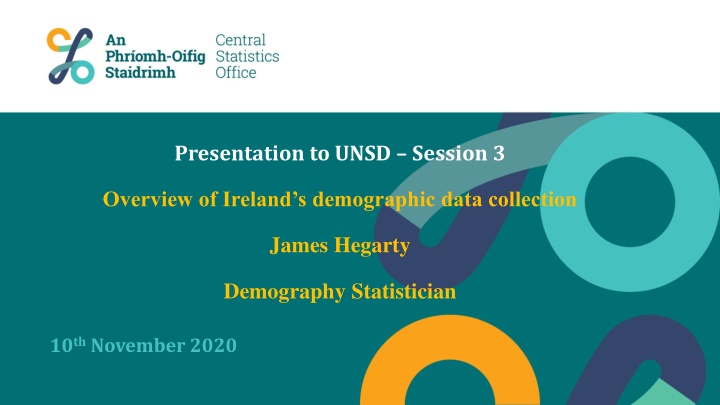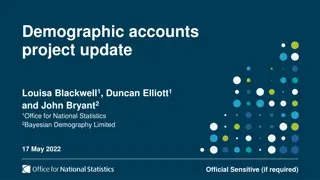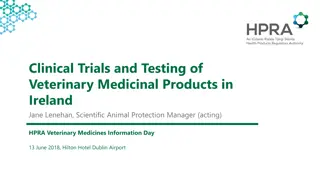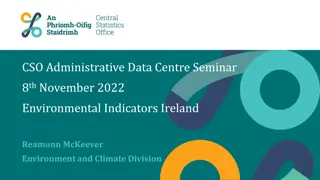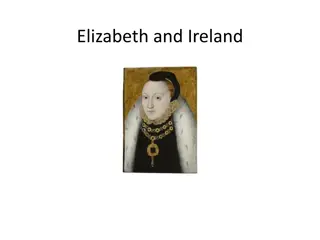Overview of Ireland's Demographic Data Collection
Ireland conducts a Census of Population every 5 years, with the most recent in 2016. Inter-Census Population Estimates are obtained annually using demographic methods. For the 2020 European Census cycle, Ireland is holding a traditional Census in 2022 due to COVID-19 impacts. A pilot administrative Census using administrative data sources is planned for 2021. The approach involves personal identification numbers, employment registers, and education registers to count the resident population efficiently.
Download Presentation

Please find below an Image/Link to download the presentation.
The content on the website is provided AS IS for your information and personal use only. It may not be sold, licensed, or shared on other websites without obtaining consent from the author.If you encounter any issues during the download, it is possible that the publisher has removed the file from their server.
You are allowed to download the files provided on this website for personal or commercial use, subject to the condition that they are used lawfully. All files are the property of their respective owners.
The content on the website is provided AS IS for your information and personal use only. It may not be sold, licensed, or shared on other websites without obtaining consent from the author.
E N D
Presentation Transcript
Presentation to UNSD Session 3 Overview of Ireland s demographic data collection James Hegarty Demography Statistician 10thNovember 2020
Census count - Ireland Ireland currently conducts a Census of Population every 5 years, most recent in 2016 The Census provides the De-facto population which meets a variety of national needs e.g. deciding the appropriate number of elected representatives Also the Usually resident population base provided for UNSD and Eurostat returns under regulation (EC) 1260/2013. Residence is 12 month actual or intended stay 2
Inter-Census Population Estimates Ireland uses the demographic component method to trend forward the Census usually resident population to obtain annual population estimates. The resident population is preferred as it meets Ireland s regulatory requirements. Components of population change are added and subtracted from the base population PlusBirths and MinusDeaths Register data from the General Registration Office for vital statistics PlusImmigrantsMinusEmigrants Migration data is estimated using questions in the Labour Force Survey (LFS) Immigrants resident or intend to be resident >12 months are counted. Emigrants who intend to live abroad >12 months are counted Updates applied on a quarterly basis, facilitates the mid-year reference required by UNSD and the end-year reference required by Eurostat Administrative sources e.g. personal identification numbers (PPSN), visa data and residence permits are examined for coherence purposes Estimates are subject to revision upon publication of the next Census 3
For the 2020 European Census cycle, many EU and EFTA countries using population registers/mixed mode instead of a traditional Census process 4
What does the future hold for population statistics in Ireland? Ireland doesn t have a population register and is holding a traditional Census in 2022. The impacts of COVID 19 have delayed the Scheduled 2021 Census by one year Pilot administrative Census - In 2021, Ireland is undertaking a pilot project to count the population from administrative data sources. Ireland has a strong and stable administrative system - use a residence and sign of life approach Personal identification numbers Employment registers Social welfare registers Education and other registers A timely, inexpensive means of counting resident population, no respondent burden Sign of life approach permitted in the new draft EU population regulation 5
Summary Each country counts it s population in a manner that meets its national and regulatory requirements Eurostat provide guidance and regulatory infrastructure for European member States Usual resident >12 months is currently required under regulation Traditional Census prominent in the EU and the cornerstone of Irish population statistics Population registers are now the most common form of Census collection in the 2020 European round Also increased use of administrative data to measure signs of life to count the resident population Allow flexibility in the methods and systems used to count the population 6
